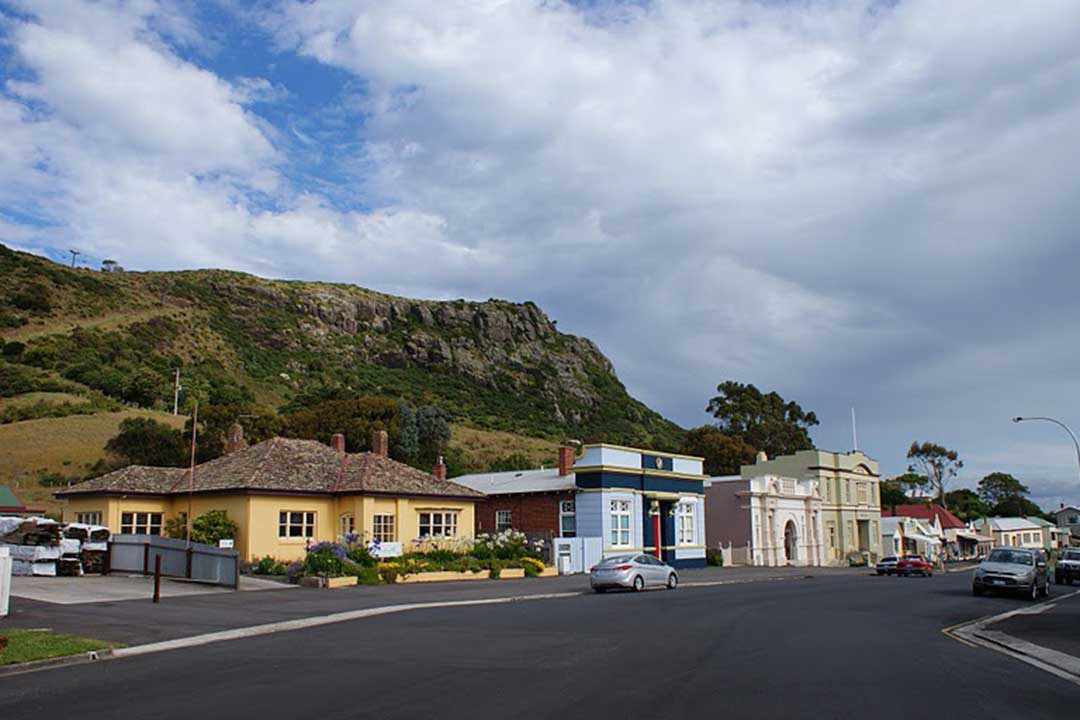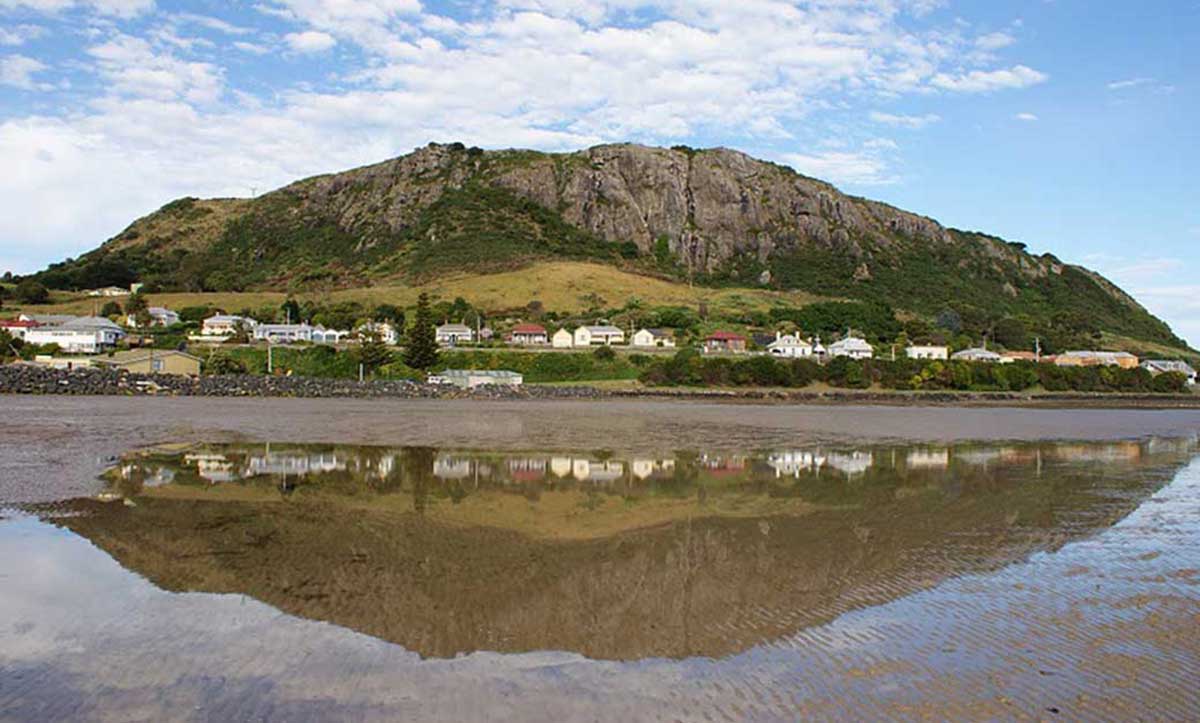
Stanley Heritage Walk
The settlement at Circular Head was established as a company town, to be inhabited by tenants, and consequently comprises mainly simple weatherboard cottages, providing good examples of vernacular timber architecture, with some masonry buildings. The buildings form fine consistent streetscapes. Most structures are single-storey, with two storey buildings limited to the main street.
Stanley as we know it started with the first gazetted street plan of Stanley drawn up by John Lee Archer, renowned architect and civil engineer and recently appointed police magistrate, in August 1843. John Lee Archer prepared a second town plan in 1848 when the population of Stanley was listed as 127 men, 41 women and 65 children. At that time Stanley had 20 shops and stores, an Anglican Church, parsonage, school and police office.
Leasing blocks of land by the VDL Company began as soon as Archer had finidhed his survey but it was not until 1851 that the first blocks of land were sold to independent settlers.
Although the importance of the town as a port has fluctuated over the years, it has always been significant, and initial settlement extended in a line from the harbur to a broader elevated area cut into the lower slopes of The Nut. The harbour includes wharves and sea walls which provide archaeological interest and enhance the character of the town.
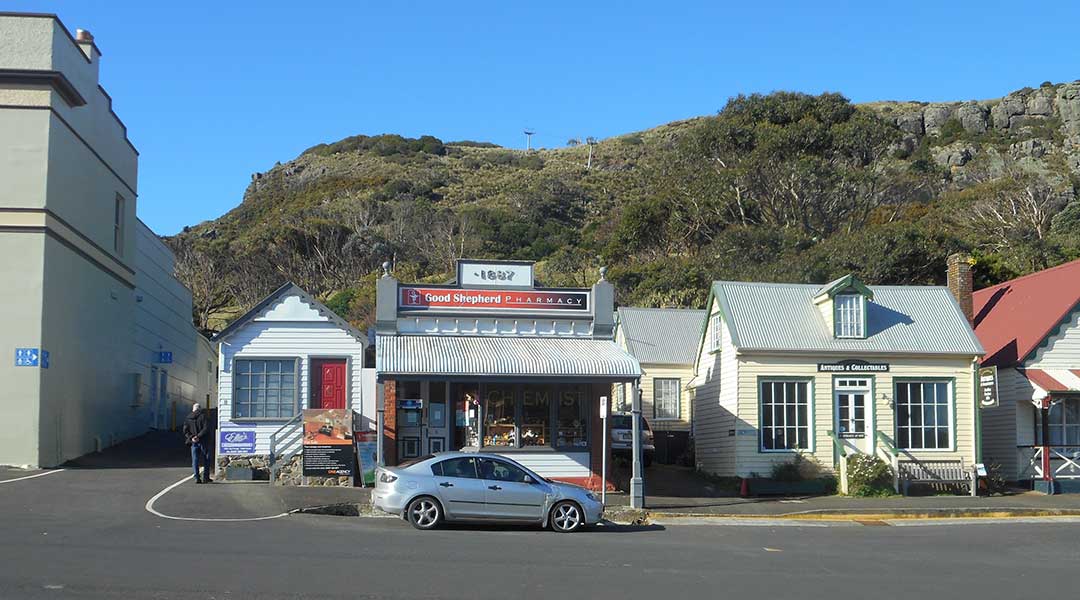
Stanley’s streetscape is remarkably preserved today, sadly however, many buildings have not stood the test of time, including the Produce Hall, the first mill, the timber kilns, and A.C. Smith & Sons’ General Store, next door to the Stanley Hotel, all of which were destroyed over the years by fire. The Smith & Sons' General Store burn down in 1962.
At Christmas the streets were always decorated with huge boughs of gum trees tied to verandah posts. The townspeople dressed up and gathered here to wish each other the compliments of the season. Meg would tell you “that’s just how it should be”. At least Santa Claus still walks the streets now on Christmas Day to throw lollies to the kids. This happens now on the annual Christmas Parade day around mid December.

Wharf area
The first wooden jetty at Stanley was a simple affair. It was built by architect and chief surveyor, Henry Hellyer, and first used by the brig Tranmere in February 1827, four months after Tranmere discharged its first cargo for the new settlement. It was located at the foot of the Nut in the hope of gaining protection from the easterlies! For nearly two hundred years, easterlies have wreaked havoc and mayhem to the substantial port area.
Crayfish and shark were plentiful off the town in the 1940s and it was said that ‘cut lunch’ fishermen could pull in a good catch and be tied up at Fisherman’s Dock by nightfall. Stanley, with its impressive deep-water facility, is still a major fishing port with an immense love of history. Here you can still see crays being caught in traditional hand-woven tea tree pots.
The Port of Stanley currently services King Island, with live cattle shipments and transporting stock to Greenham’s Abbatoirs in Smithton, and the Fishermen’s Dock is still a hive of activity with a busy, viable fishing industry handling crayfish, scallops, octopus, and various species of fish.

Situated near the wharf at 15-17 Wharf Road, opposite the intersection with Alexander Terrace is the Old Custom Bond Store, a two storey bluestone bond store built in 1835 from ships ballast. The Georgian style bluestone Bond Store was built in excavation below the natural level and features arched openings and 20-pane windows. It has also been used as a lock-up, customs house, butter factory and fish processing factory. The store was designed by J. Lee Archer.

Stanley VDL Store
The VDL company store, 16 Wharf Road, backing onto Alexander Terrace, was built in 1843, and also designed by J. Lee Archer. It aimed to provide cheap wool to British factories throughout the 1800s. And the last stop on the walk is the Bond Store. This bluestone building was erected 1835 using recycled Baltic pine and stone from the ballast of early sailing ships. The store served aristocrats by storing everything imported that was meant for a gentlemen's estate. It was restored in 1980 as a community centre.
Archer, who designed and built the Store, also worked in Stanley as the Chairman of Quarter Sessions, the Commissioner under the Electoral Act and the Assistant Commissioner of the Court of Requests.
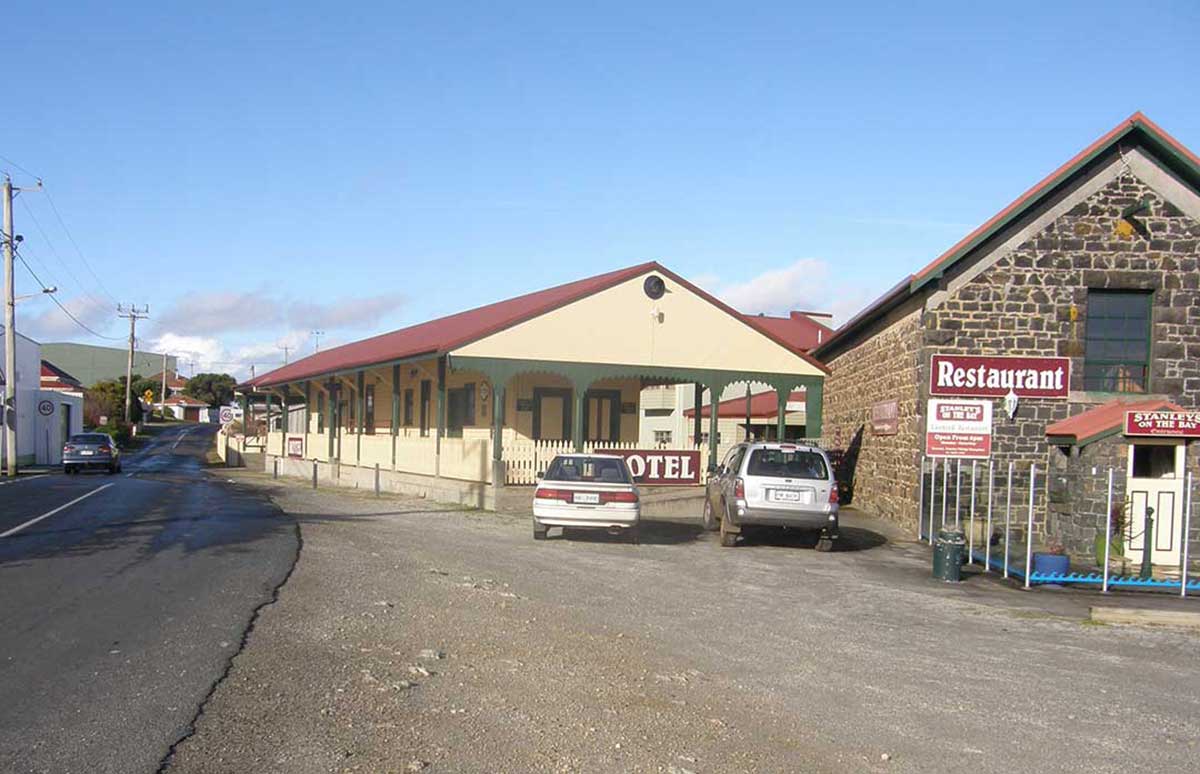
Former Stanley railway station
The railway came to Stanley in 1913, when it was linked by a single narrow gauge line from Burnie. Known as the Far Western line, it was then extended from Myalla station to Irishtown (1919), Smithton (1921) and Wiltshire (1922). From Burnie to Wynyard, the line closely follows the coastline of Bass Strait, for the majority of route between the main road and the water, before turning inland and passing through the south of Wynyard township. Rail services to Stanley began to wind down when passenger services ended entirely across the Tasmanian rail network in 1978.
Alexander Terrace

6 Alexander Street
6 Alexander Street is distinctive white walled and red roofed two storey cottage with an extraordinary story attached to it, one which presents a remarkable commentary on life amongst British royalty of the time. It's one of John Lee Archer's buildings, built in 1839 for one of King George IV's many illegitimate sons. Which one of the many of this dissolute monarch's many offspring born out of wedlock was the intended occupant is not known, but it was most probably Samuel Blackwell, who had supposedly been paid an undisclosed amount of money to leave England. He migrated to Van Diemen's Land in the same year the house was built, and later established the Melton Mowbray Hotel. 1839 was also the year Archer moved to north-west Tasmania to take up the position of police magistrate for the district of Horton. He lived in the two-storey Alexander Street home with his wife, Sophia, and their eight children until his death on 4th December, 1852. You can visit his final resting place at the Stanley Burial Ground. The home is owned privately by the great granddaughter of Edward Curr, first chief colonial agent to the Van Diemen’s Land Company, formed in London in 1825, and headquartered in Stanley to establish a fine merino wool industry.
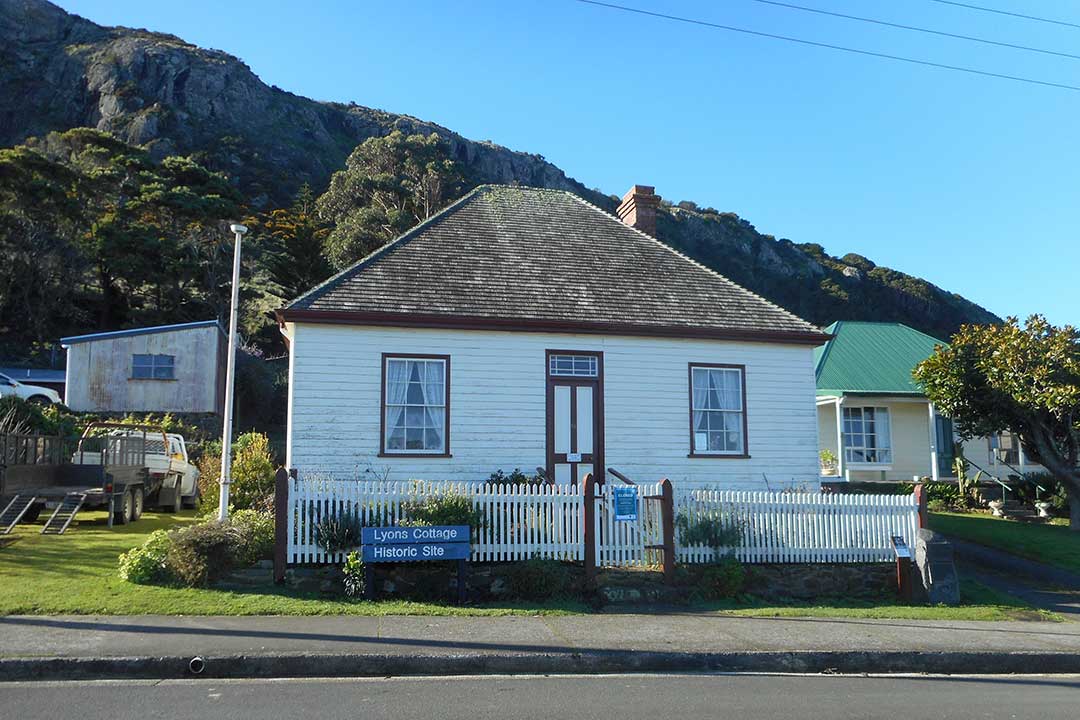
Lyons Cottage
The timber cottage at 14 Alexander Terrace, known as Lyons Cottage, was the birth place in 1879 of Mr J.A. Lyons, who was one of Tasmania's great statesmen, as Premier from 1923-1928, and the only Tasmanian-born Prime Minister (1932-1939). Built in the 1840s, the small timber Georgian cottage is a good example of a mid-19th Century dwelling. Joe attended the local Stanley school and started his teaching career here before his political career in 1909. By 1914 Joe was deputy leader, then in 1923 elected as State Premier. Joe remained premier till the party lost office in 1928, before moving into federal politics in the Scullin Labor ministry in 1929.
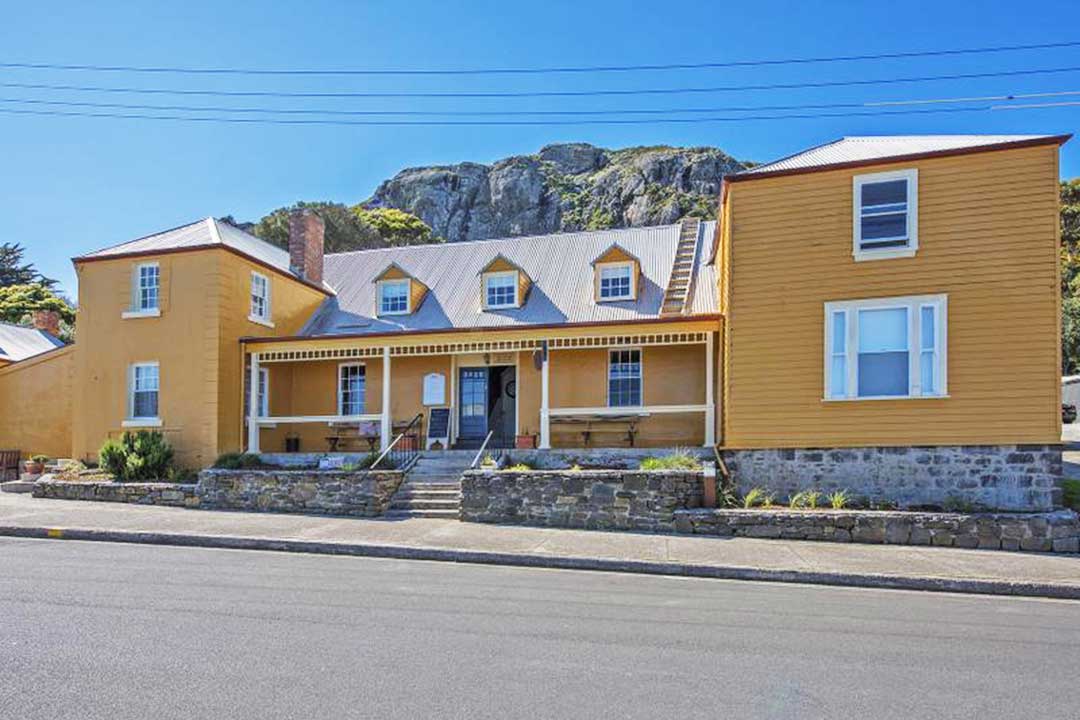
Bay View Hotel and Stables
The Bay View Hotel and Stables, 16 Alexander Terrace, were built c. 1849, as The Shamrock Inn, and licensed to Michael Lyons (grandfather of Joseph Lyons). The first license for the part-stone, part-weatherboard hotel was issued to Michael Lyons, who was engaged by the Van Diemen’s Land Company to manage the large cattle run at Woolnorth. Michael was the grandfather of former Prime Minister Joseph Lyons, so it’s possible that Joe Lyons drank his first beer at the bar here.
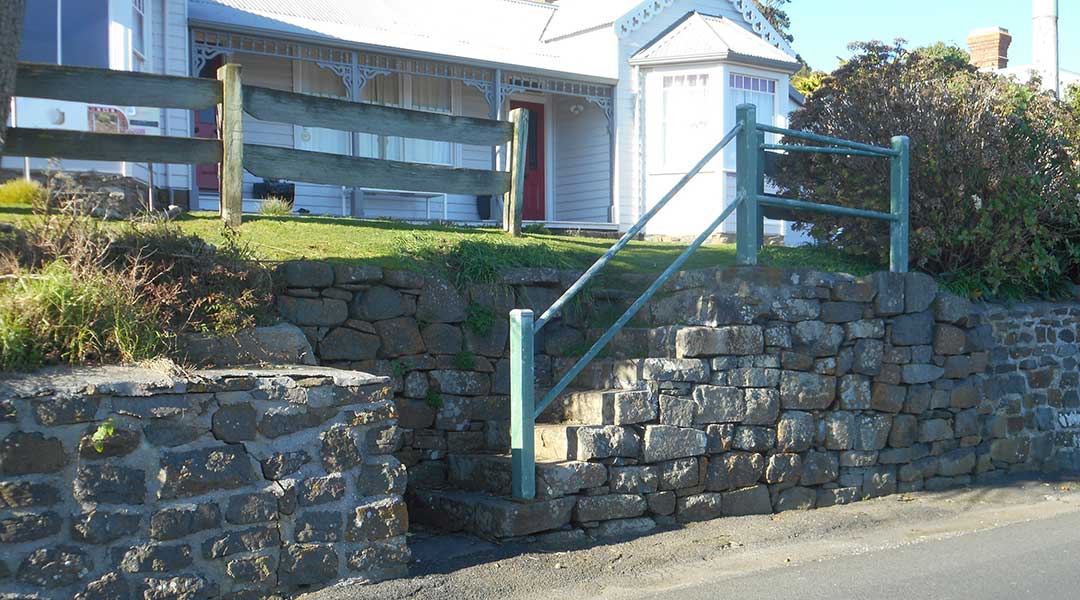
The stone wall between the high and low sections of Alexander Terrace is a dry-laid bluestone retaining wall built c.1900 with stone quarried from The Nut.
Little Talisker, 28 Alexander Street, is a 2 storey weatherboard cottage built in 1892. It is named after Talisker House which was built in the 1700s on the Isle of Skye in Scotland. The cottage is today a B&B.
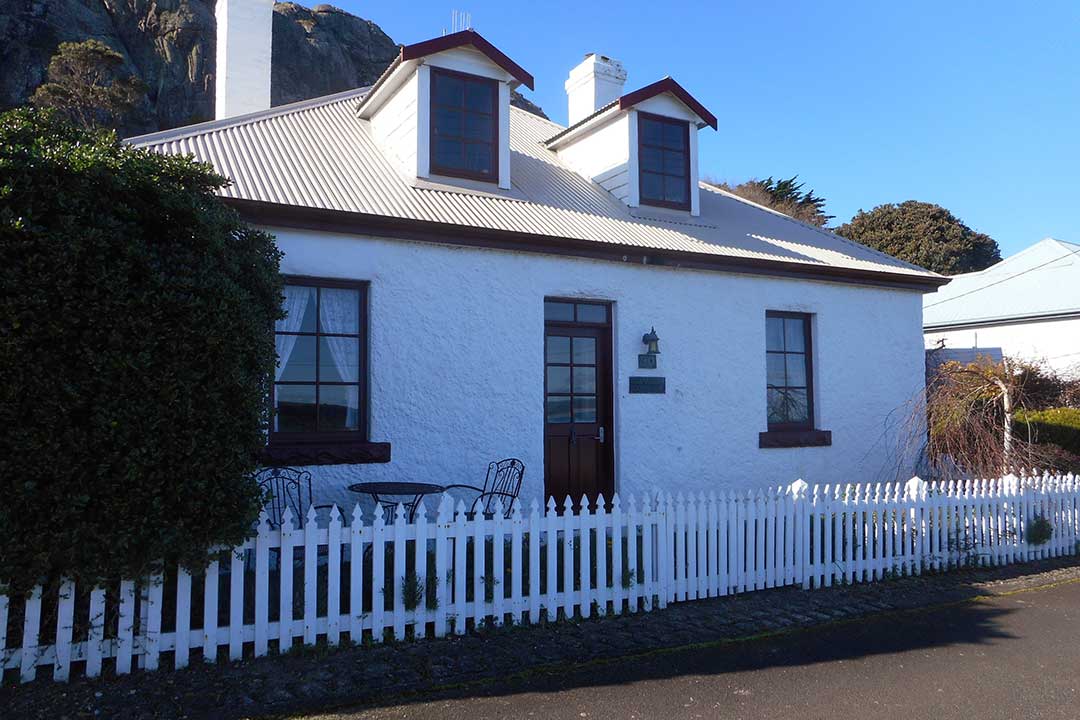
Captain's Cottage
Captain's Cottage, 30 Alexander Terrace, is a remarkable name for a building in Stanley as there have been scores of captains living in town over the years. This 1835-built cottage was once owned by Captain Frederick Burgess. The path up to The Nut starts not far from Captain’s Cottage.
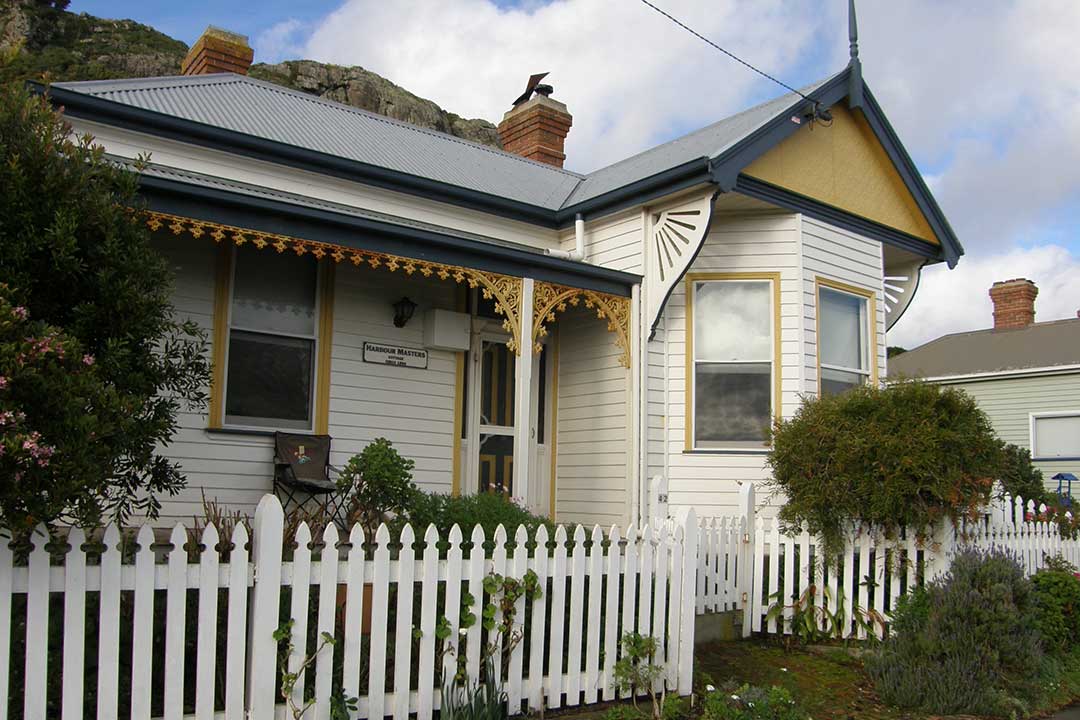
Harbourmaster's Cottage
42 Alexander Terrace was built as the Harbourmaster's Cottage. Built in 1880, is another fine example of a fastidiously maintained weatherboard home.
Church Street
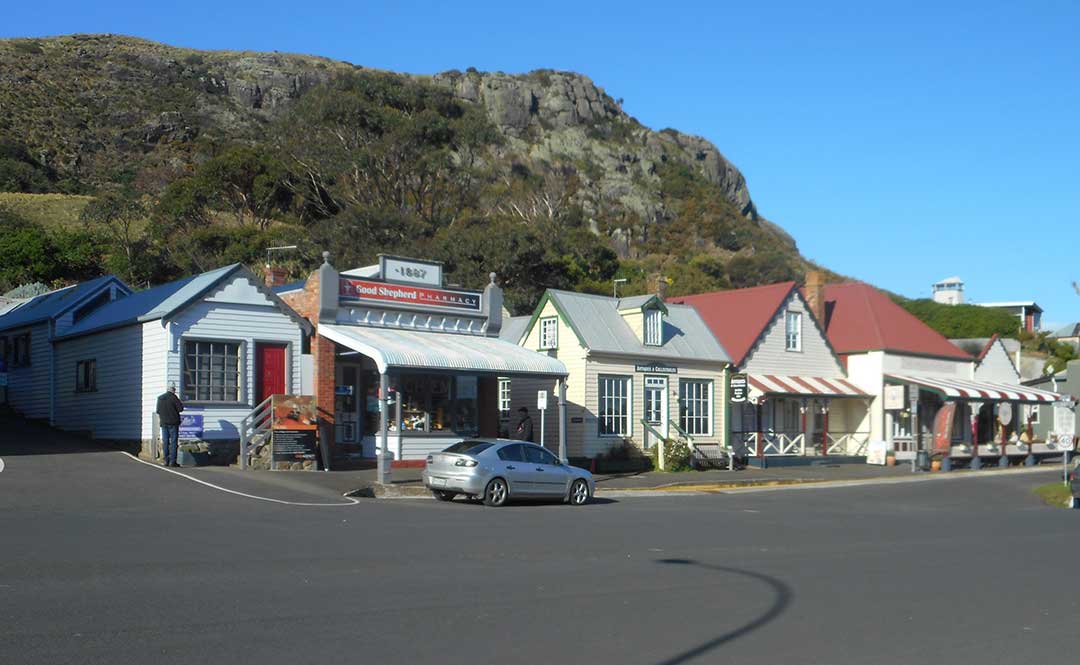
4 - 6 Church Street
The snug row of little shops at 4 - 8 Church Street that first showed up in photographs in 1860 still serves the town. Around that time, their shop fronts included a Draper’s Shop, Barbers, General Store, Milliner and Dressmaker, Saddler and Boot Emporium. No. 8 Church Street comprises of 2 self contained cottages plus a shopfront. They are now used for holiday rental accommodation under the name Ellie's Accommodation.
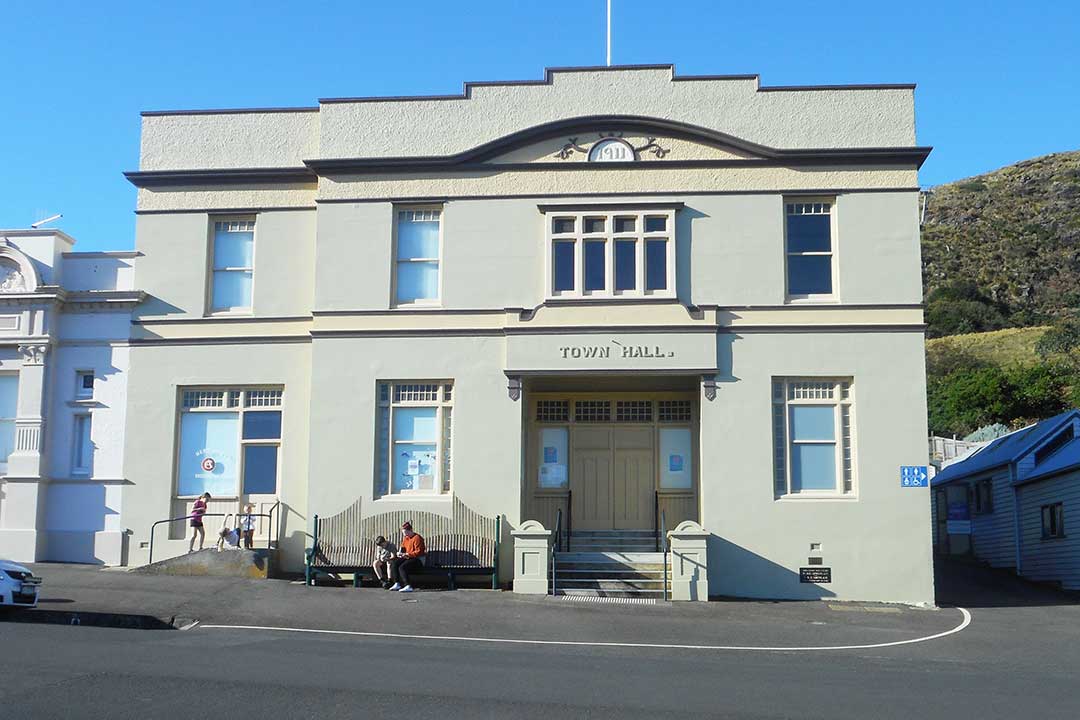
Stanley Town Hall
Stanley Town Hall, at 10 Church Street, opened in 1911. The architect was Alexander North (1858-1945) who emigrated from England to Tasmania in 1883. He was known as an outstanding church architect, and a pioneer of concrete construction in Tasmania. The building is a freestyle federation two-storey structure, and the walls were constructed in a series of horizontal concrete pours. The main auditorium has been renovated in the art deco style of the 1930s. There was live entertainment, and the Crystal Talkies cinema.
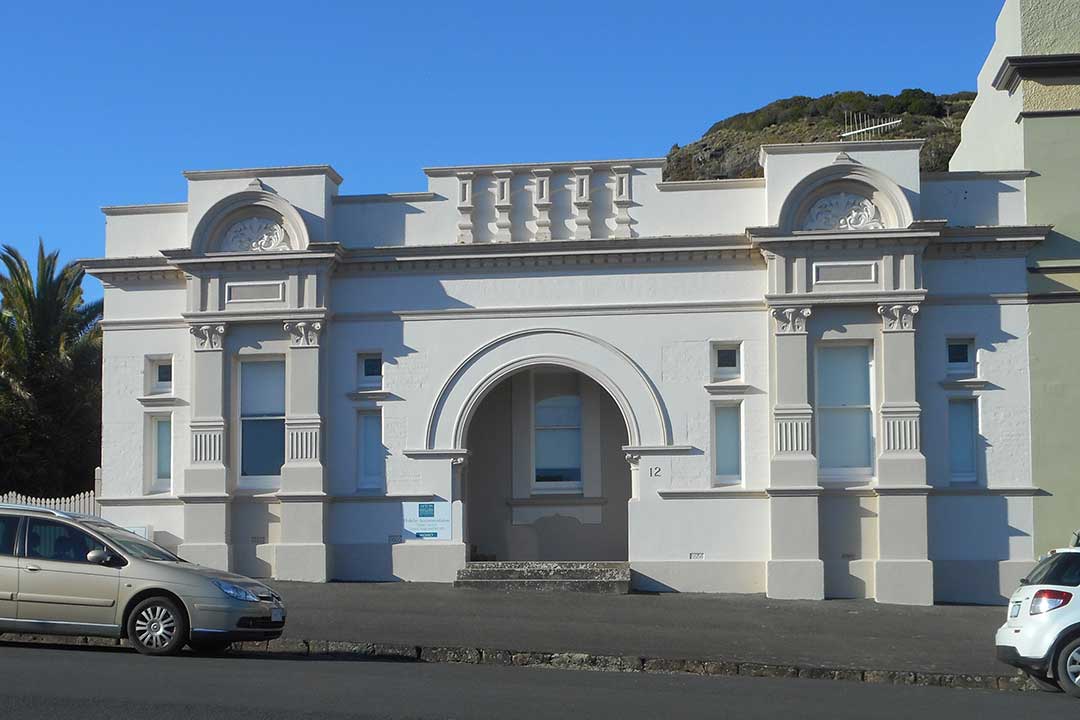
Stanley Town Hall
12 Church Street was built in 1904 for the Commercial Bank of Australia Limited. Known for years as The Old Bank, it has been transformed into a 3 bedroom, 3 bathroom residence. The building to its left - 14 Church Street - was formerly an ANZ Bank.
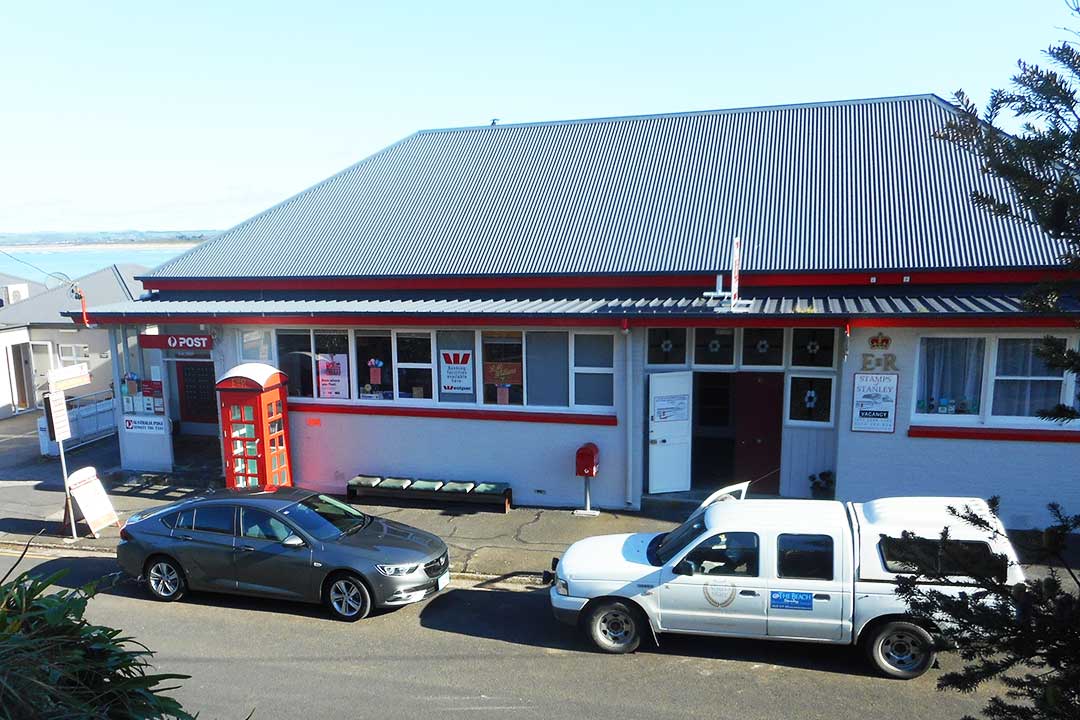
Post Office, Customs House & Telephone Exchange
Stanley's original Customs House & Telephone Exchange, 11 - 13 Church Street, was built in 1897. The building is still home to Stanley Post Office, as well as Stamps of Stanley, offering accommodation in rooms with the post office building.
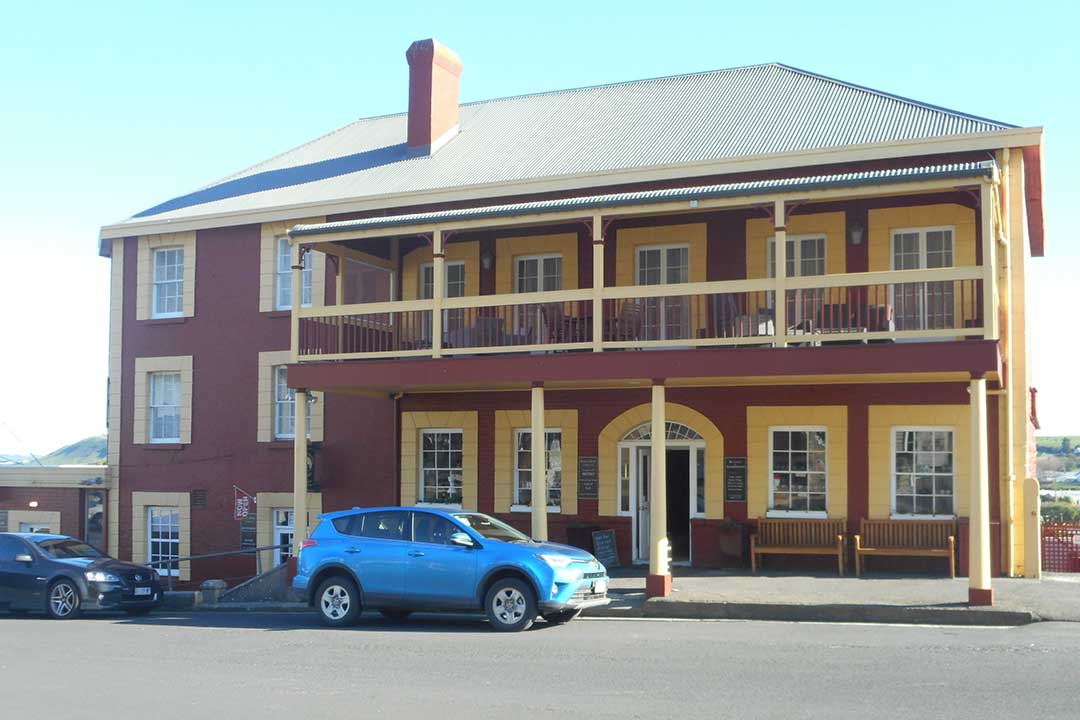
Stanley Hotel
The Union Hotel, 19 Church Street, corner Victoria Street, is a two storey Georgian style building, with an unsympathetic verandah added over part of the facade. Fenestration suggests it was built in two sections. Quoins and window surrounds ironed in imitation of rusticated ashlar. Other features include twelve pane windows, double entry doors with sidelights and fanlight and an iron hip roof. Built in 1849, it was first licensed as the Emily Hotel to John Whittbread; Other licensees included Michael Lyons (from 1860) and Patrick Breheny (from 1867). It is currently known as the Stanley Hotel.
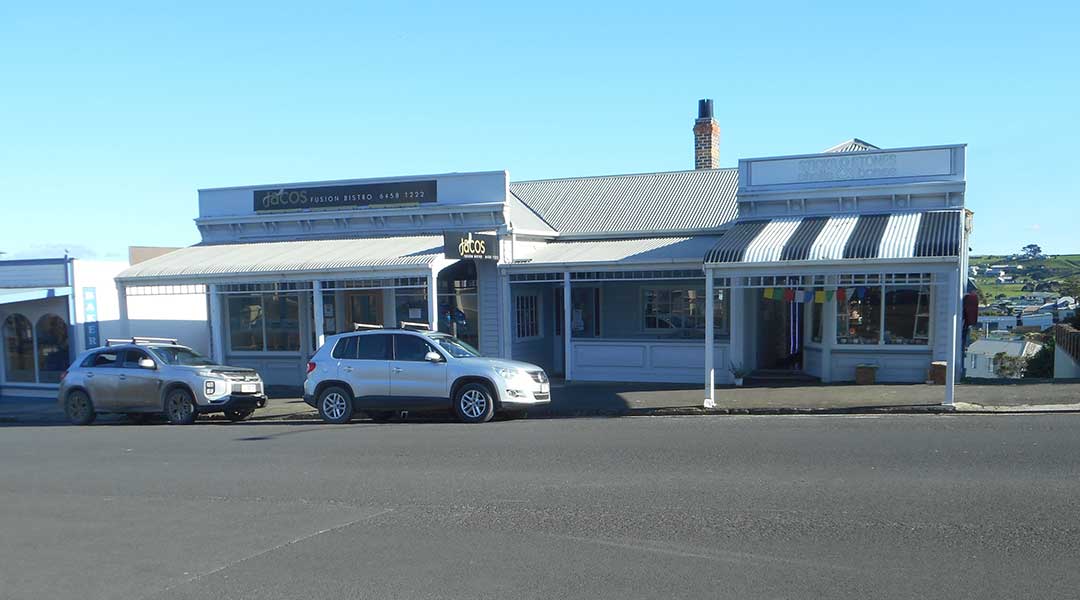
23 - 27 Church Street
23 - 27 Church Street - this row of commercial heritage buildings date back to 1888 with various uses including a store, milk bar and the Stanley branch of the Savings Bank of Tasmania (27 Church Street). The buildings are currently a restaurant and the Sticks & Stones Shells & Bones gift shop.
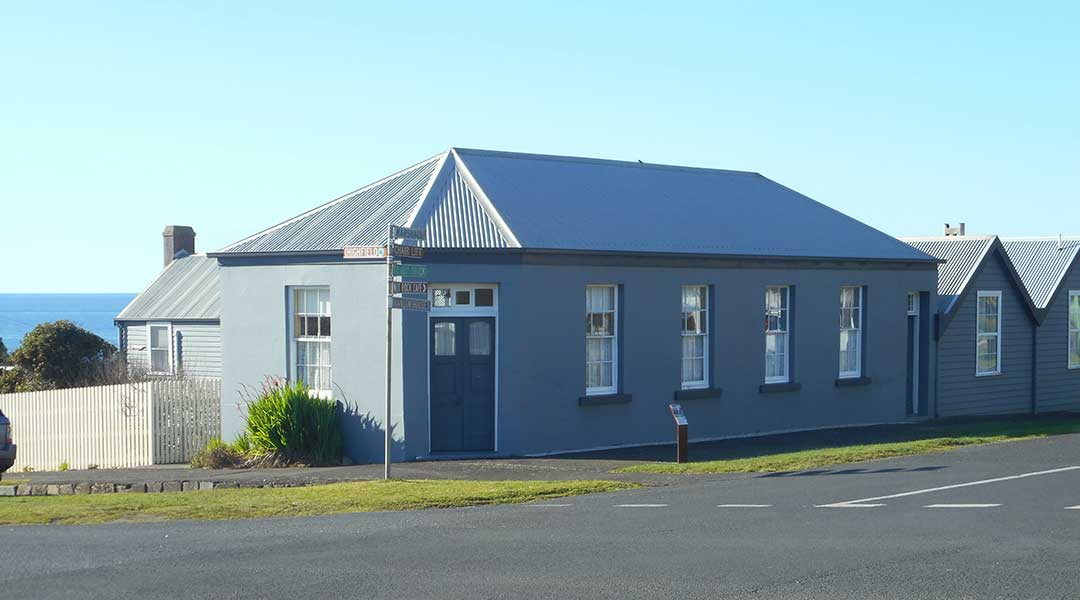
Commercial Hotel
The Commercial Hotel (former), 28 Church Street, corner Marshall Street, was built as a colonial inn of two parts. The timber section is shown on John Lee Archer's 1842 plan, with the brick and stucco wing apparently built soon after. There is some conjecture that the complex was much larger and the remains of stone walling gives this some credence. It has a single storey brick and stucco main wing with iron hip roof, splay corner entry, twelve pane windows. Additionally, the building has a one and two storey timber wing with iron gable roof, two pane windows. There are cellars to both wings. The building operated as the Commercial Hotel from 1844 to 1946. The property was renovated to its present condition in 1975.
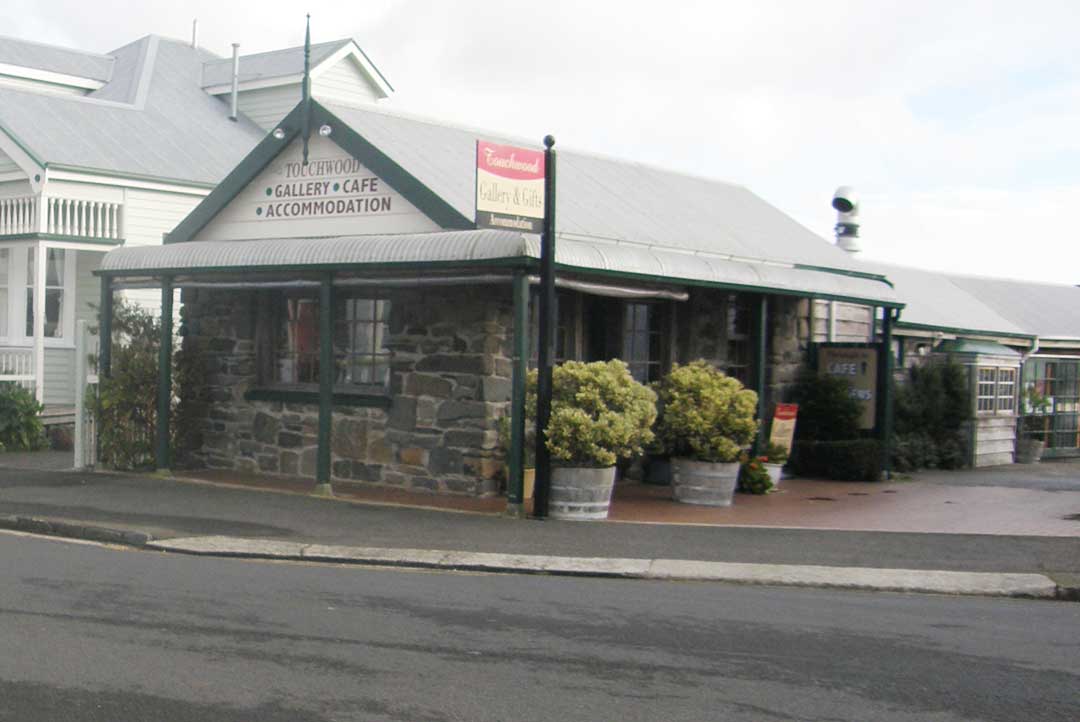
Touchwood Cottage
Touchwood Cottage, 31-33 Church Street, is a single storey cottage with a stone wing and wall at the rear. Georgian style random rubble stonework front section is rendered. Mr William Staghouse Smith, who built many of Stanley's early homes and other buildings, added a verandah and Edwardian gable and incorporated a dairy when he became the owner c.1900.
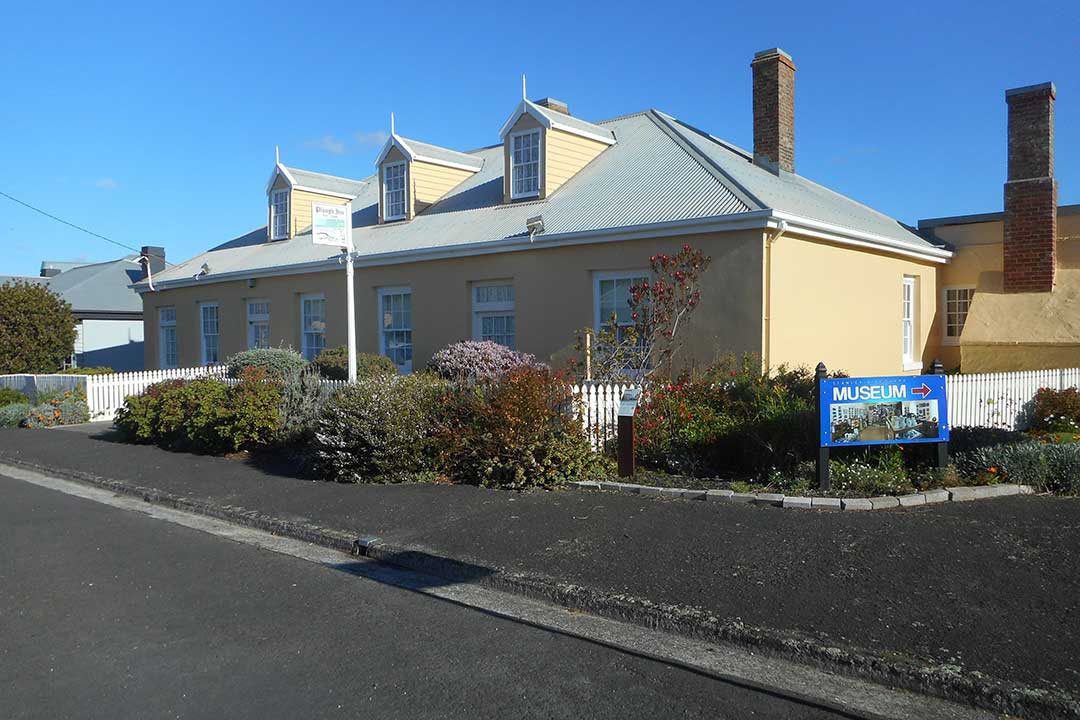
The Plough Inn
Spicer's Building (The Plough Inn), 35 Church Street, is a single storied brick and stuccoed Georgian terrace with an iron hipped roof and three 12-pane dormers with finials. Built c. 1840, it was built by the Van Diemen's Land Company to house visitors from Hobart and fulfilled that function until its licence lapsed in 1876. It was later as a dispensary and a branch of the National Bank of Tasmania. Recently, it has been restored and furnished with antiques. A baker's oven located on the side next to the church was used to bake bread for the whole village.
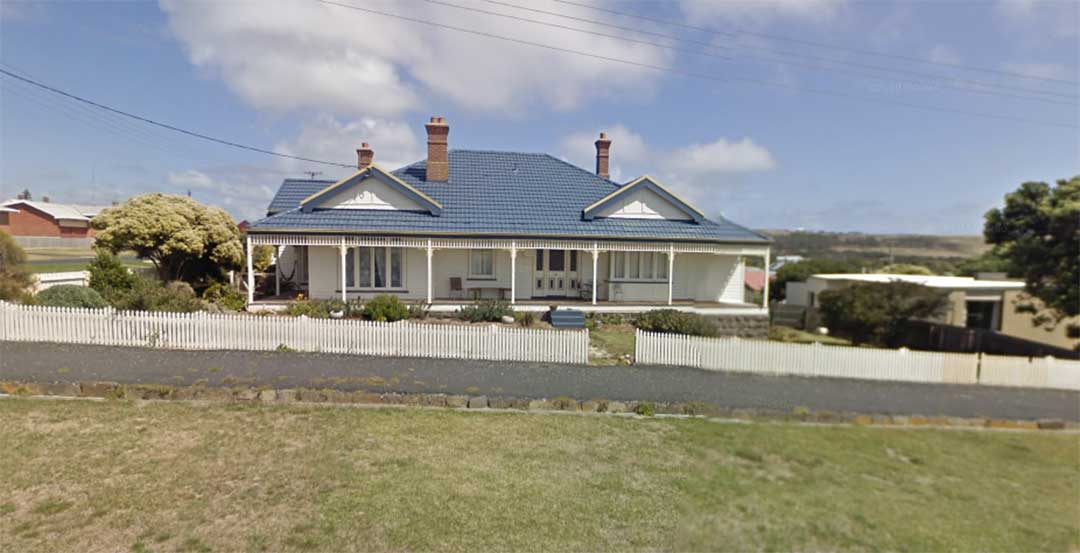
Laughton House
Laughton House, 45 Church Street, was built in 1906 by the local solicitor Kenric Laughton and occupied by the Laughton family until 1984. This fine restored Edwardian houe has excellent views over Tatlow Beach and is characterised by large rooms with ornate fire places. It is now used as an visitor accommodation.
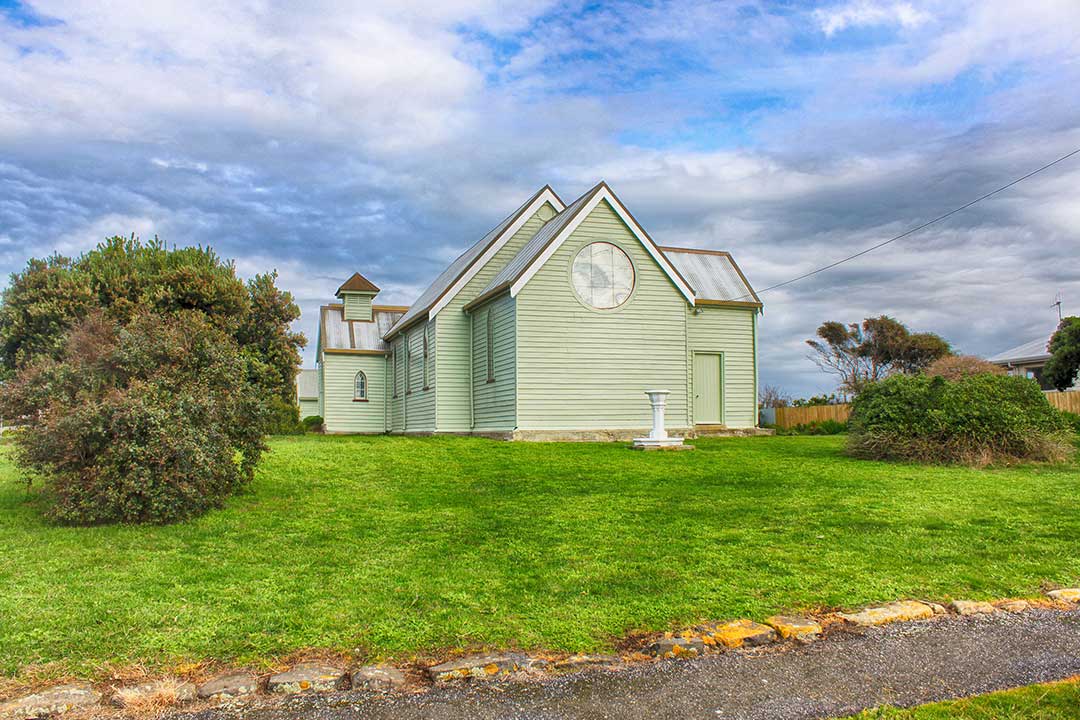
St Paul's Anglican Church
St Paul's Anglican Church, cnr Church and Fletcher Streets, was originally stone-built in 1842, but it had to be demolished due to salt water cracks in the walls. Rebuilt in timber in 1887, the church still stands for you to enjoy. You'll then head to the nearby Commercial Hotel. Originally built as a mess hall for officers in the Van Diemen's Land Company, the building operated as one of Tasmania's oldest hotels until the 1960s. The community hall attached is now home to the Stanley Discovery Museum.
Pearse Street
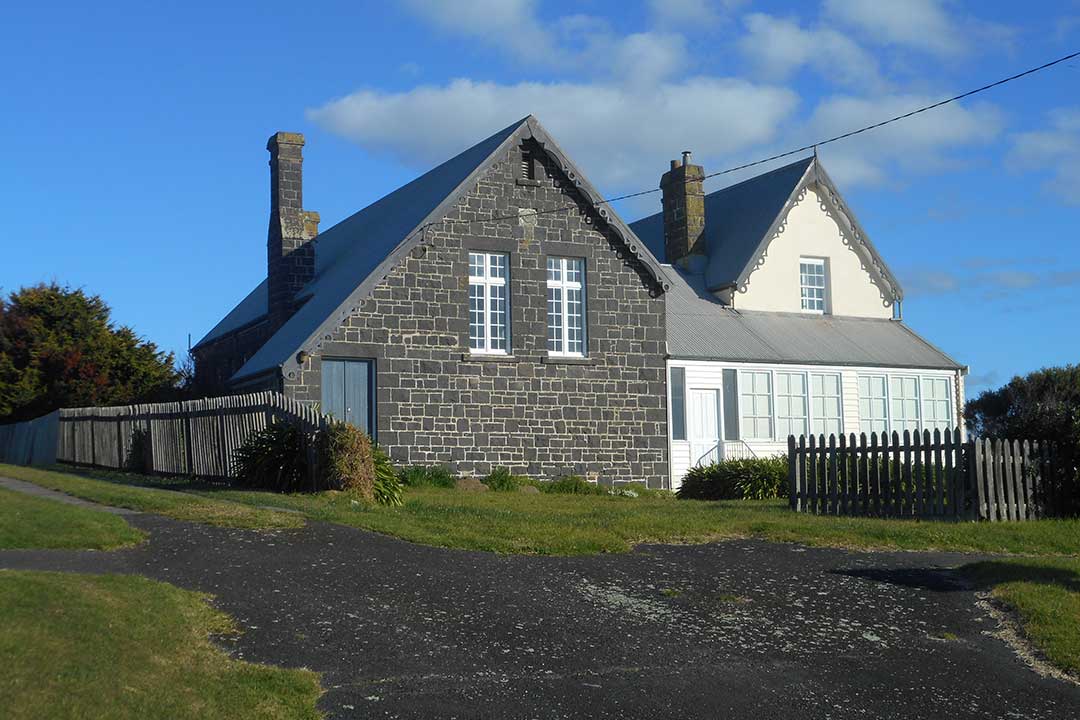
Old School Residence and Hall
The Old School Residence and Hall, 26 Pearse Street, is a Victorian Gothic bluestone school building erected in 1865-6 for a contract price of 840 pounds. was built in 1866, and subsequently extended. This was the state school attended by Joseph Lyons in the years 1892-94. The one and a half storey building features two by ten pane casement windows with eight pane transom window, decorative barges and an adjoining one and a half storey gable with enclosed verandah to two sides.
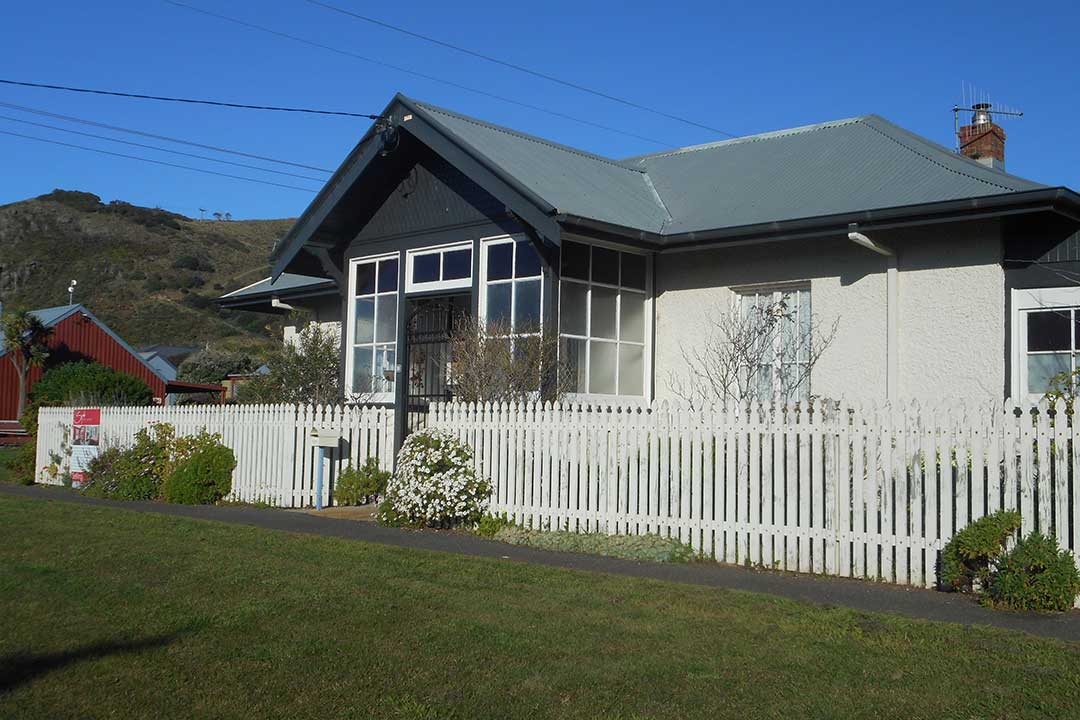
The Rectory
The Rectory on the corner of Pearse and Cripps Streets was built c. 1850. Although the single storey Victorian stone house has an altered facade, the interiors are largely intact. Now a private residence, it served as quarters for Anglican ministers from its construction in 1843 until 1988.
Other Streets
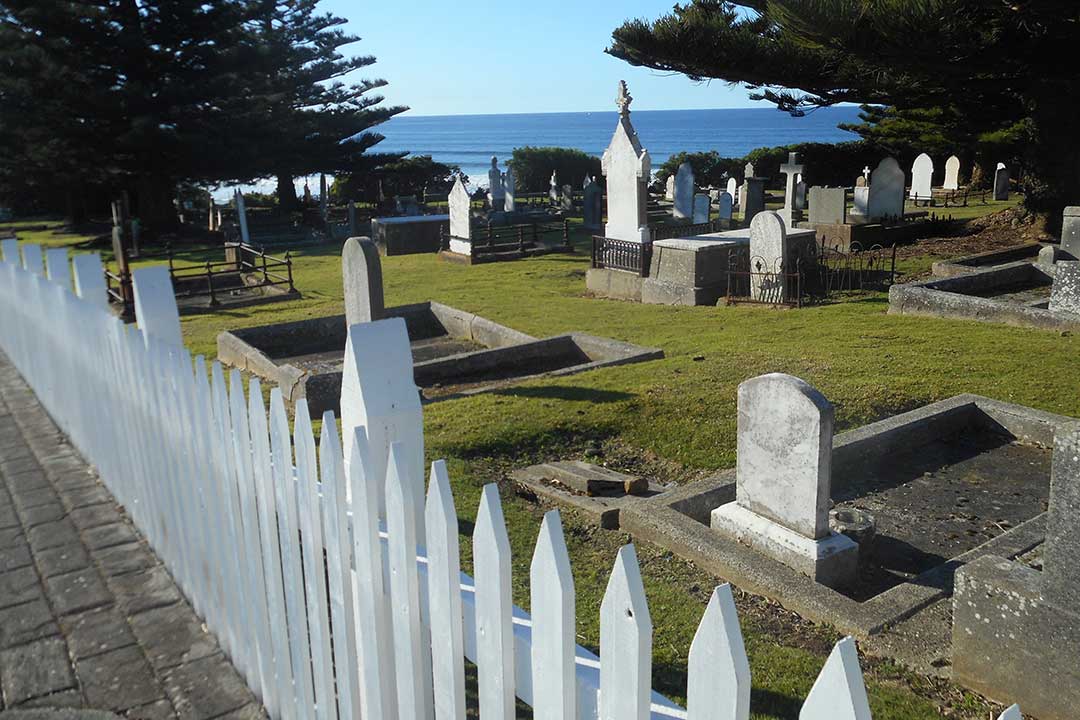
Stanley Cemetery
Stanley Cemetery, Harrison Terrace: Since the first internment in 1827 until the last in 1997, Stanley’s old cemetery has been the final resting place of Circular Head’s European settlers and their descendents. Located overlooking Bass Strait the burial ground’s directory lists the names of over 700 people interred, more details of which are available on request at the Stanley Visitor Information entre.
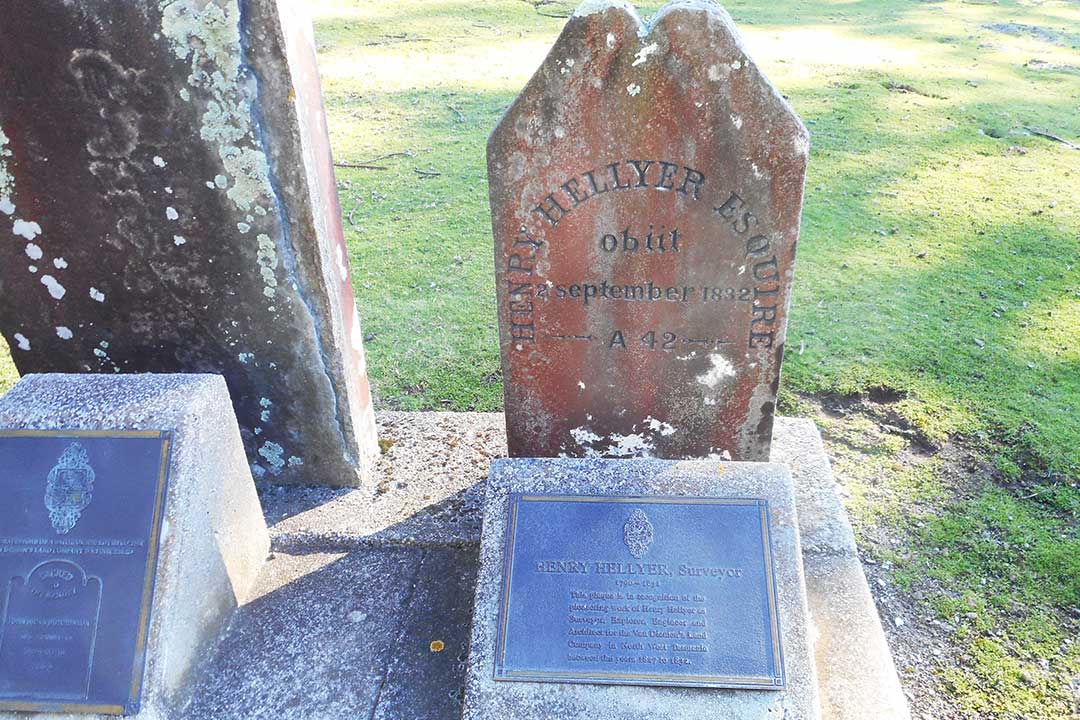
Grave of Henry Hellyer
Located at the foot of The Nut and overlooking the beach, the cemetery contains many graves of local European settlement pioneers, including those of Colonial Architect J. Lee Archer, who planned the town and designed several buildings, and explorer and surveyor Henry Hellyer, who first explored the north-west region of Tasmania. Loction: Smees Road, Stanley
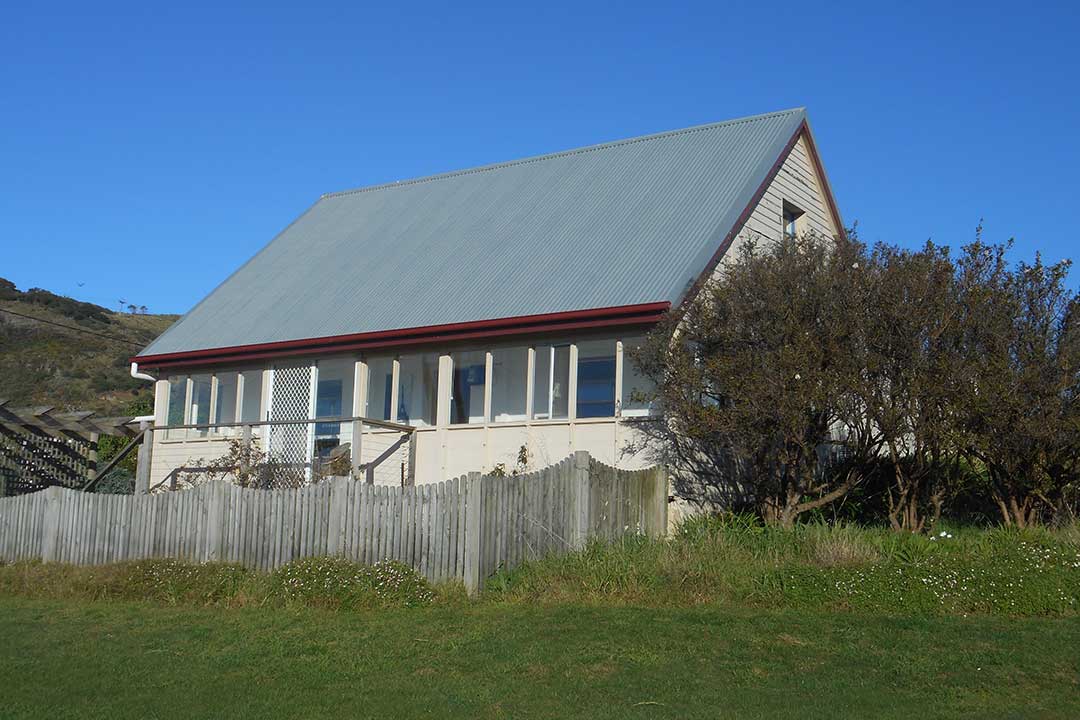
Leale's Cottage
Leale's Cottage, 12 Rougemont Street, corner Cripps Street, is a single storey rubble stone cottage with attics and numerous additions, built before 1850.
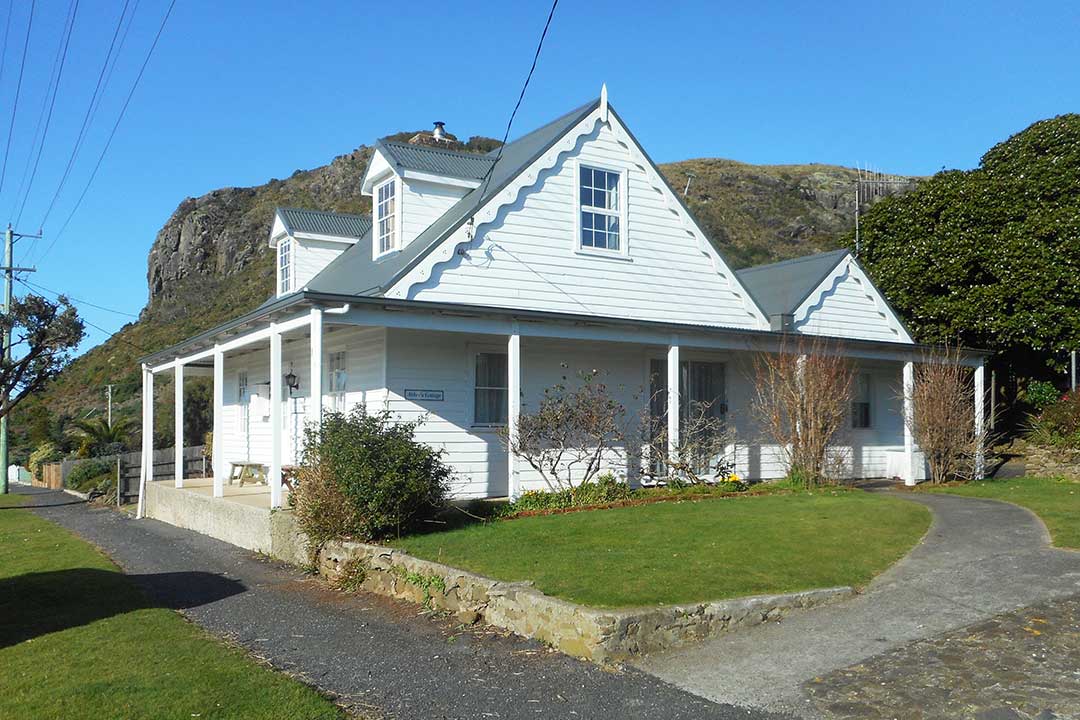
Mrs Robinsons house
Mrs Robinsons house, 1 Marshall Street, is thought to be one of the oldest timber buildings in Stanley. The simple single storey timber cottage includes attic, 12-pane windows, decorative barges and a gabled roof.
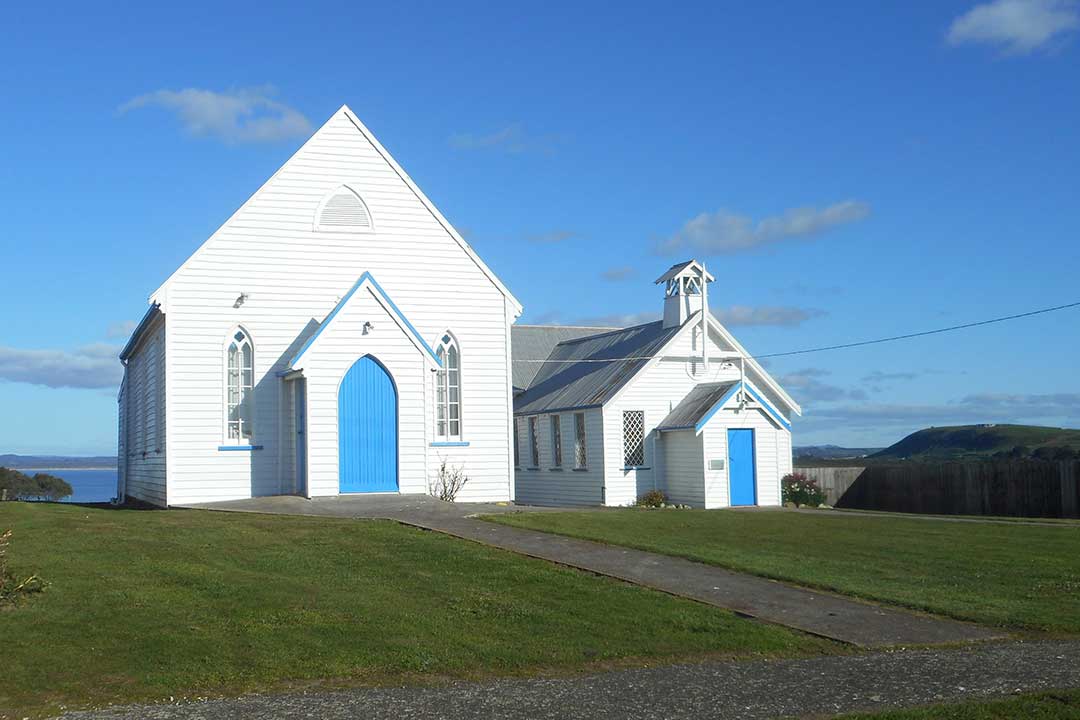
St James Presbyterian Church
From the St James Presbyterian Church, 6 Fletcher Street, you'll find impressive views of Tatlow's Beach. The building itself was bought in London in 1855 – the first pre-fabricated church to be brought to Tasmania – and transported to Stanley at a total cost of £400. It was built on an acre of land granted by the Van Diemen’s Land Company. You'll find the Mary Bogue's grave right next to the church. An aboriginal woman otherwise known as Black Mogg, she lived with the town's convict-turned-constable David Howie. Their cutter sank rounding The Nut one fateful afternoon. David swam to shore safely, but Mary and their infant son were trapped in the captain's quarters and perished. There are still many unanswered questions surrounding the sad tale.
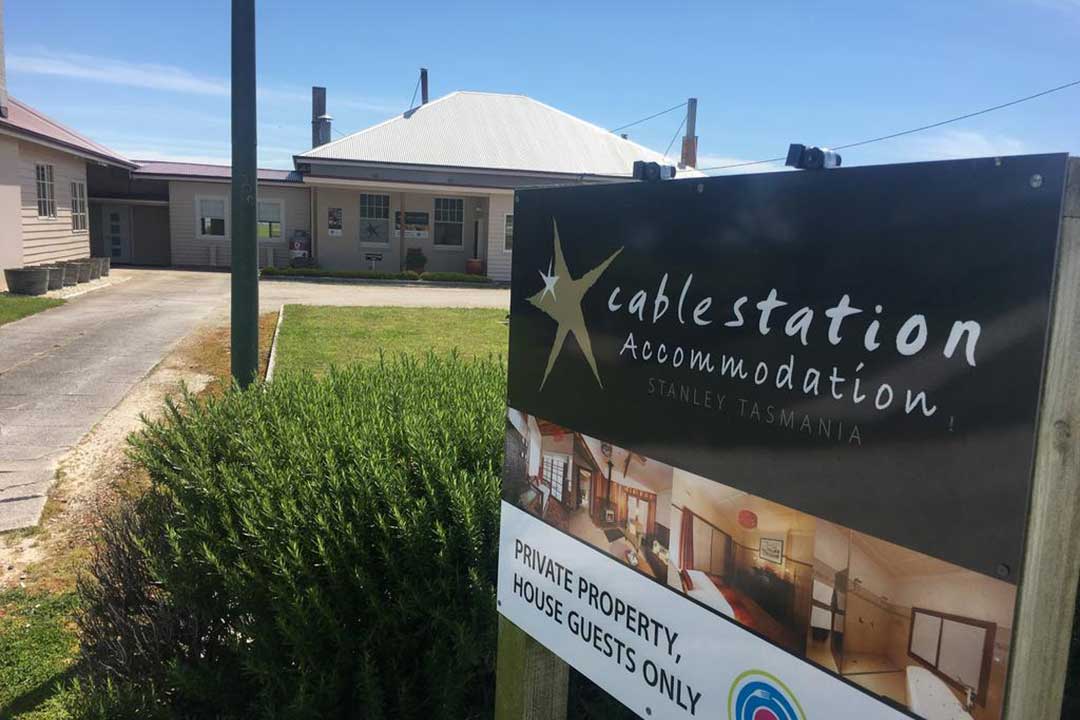
Old Stanley Cable Station
The Old Stanley Cable Station is located at 435 Green Hills Road, Stanley. As early as 1859 Tasmania was linked to the mainland of Australia by a cable laid across Bass Strait this could be used only for telegraphy communications. Three repeater stations were erected at Apollo Bay, King Island & Perkin’s Bay (Stanley). This was to be the longest cable of its kind and the most modern in the world. The eyes of all communication authorities as well as the engineering world were on Australia as the task was commenced.
During the 2nd world war, the Army commissioned the use of the other Bass Strait cables to assist with operations in the battle for New Guinea. Throughout this time, Tasmania was entirely dependent on the single cable from Stanley, via King Island for its only reliable tele-communications with mainland Australia. As such, the Cable Station had a small home guard garrisoned to guard over it. The cable was taken out of service in 1967 and today modern communication systems are more reliant upon ‘satellites’ and a new ‘optic fibre’ cable that was laid in June 2003 by Telstra. The Cable Station is now used as tourist accommodation.
The Street Names of Stanley
John Lee Archer not only laid out the streets of Stanley in 1842, but also named them, predominantly after past and present directors of the Van Diemen's Land Company.
Cripps Street - Joseph Cripps (1765-1847), London Director, VDL Co.
Harrison Street - Thomas Harrison, London Director, VDL Co.
Rougemont Street - George Rougemont, London Director, VDL Co.
Pearse Street - Brice Pearse (1800-1866), London Director, VDL Co.
Fletcher Street - Edward Fletcher, London Director, VDL Co.
Marshall Street - Edward Marshall, London Director, VDL Co.
Wilson Street - Francis Wilson, an inaugural director of the VDL Co.
Browns Road – William Ruddle Brown (1789-1847), London Director, VDL Co.
Alexander Terrace – Henry Alexander (1787 - 1861), London Director, VDL Co.
Hale Street – C.G. Hale, London Director, VDL Co.
Edwardes Street - Thomas Dyer Edwardes (1807 - 1885), London Director, VDL Co.
Church Street – the street on which land was set aside for 2 churches
Victoria Street – Queen Victoria
Albert Street - Albert, Prince Consort (Prince Albert of Saxe-Coburg and Gotha), husband of Queen Victoria
Ford Street – Frederick Wilbraham Ford was originally planning to enter the Church of England ministry but instead emigrated to Tasmania arriving in Launceston in 1841. He eventually married Ellen Eliza King and moved to Circular Head. He became a Van Diemans Land Co tenant farmer in Forest, Tasmania in 1845. He leased Highfield in 1857, ran a large produce and commission business, grazed large numbers of sheep and cattle on the Islands off Circular Head and acquired land at Marrawah. He died in 1893.
Stanley - named after Lord Stanley, Edward George Geoffrey Smith-Stanley (1799-1869), 14th Earl of Derby, British Secretary of State for the Colonies in the 1840s.

